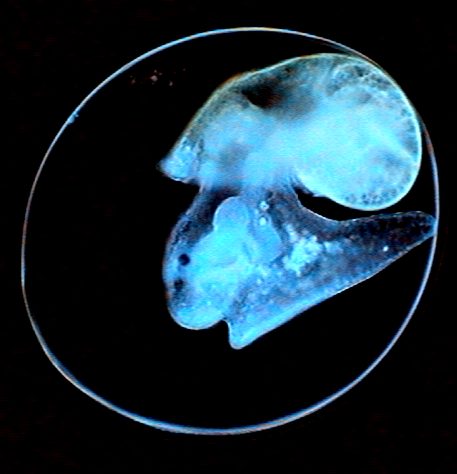
|
The development of
Physella,
a Freshwater Snail Part 1 WALTER DIONI CANCUN, MEXICO |
INTRODUCTION
Nevertheless there are some terrestrial ones (Wikipedia says that 2000 years ago the culture and the gastronomical use of some species of the genus Helix were usual) and also there are freshwater inhabitants (clams and snails). The snails frustrate the aquarists, whose aquariums they invade explosively and are very difficult to eradicate afterwards.
In the aquarium of my grandson a little species of "Physa" no longer than a centimeter and a half, created a serious problem, until soliciting the aid of the family biologist for eradication, but instead of fighting the invasion was gladly dedicated to gather ootheca and to take pictures of the embryos.
Many terrestrial and fresh water mollusks are gastropods. That is to say, they walk "crawling on their stomach". Although this definition is not to be taken in a very literal sense, all the gastropods (terrestrial, marine or from fresh water, with or without a shell) have a dorsal visceral hump and a ventral crawling foot, and move from place to place waving slightly the inferior surface of the fleshy foot on which they slide while secreting a fine mucus layer that serves them as a highway. The shelled species have one helically coiled shell that lodges and protects all the most important organs, and they extend towards the front a cephalic extremity finished by the median and frontal mouth, two sensorial tentacles and two with eyes.
All those that have observed with attention the garden snails know that, in the end of each tentacle, one can see a black ocular spot. All the gastropods that have this character are named Stylomatophores.
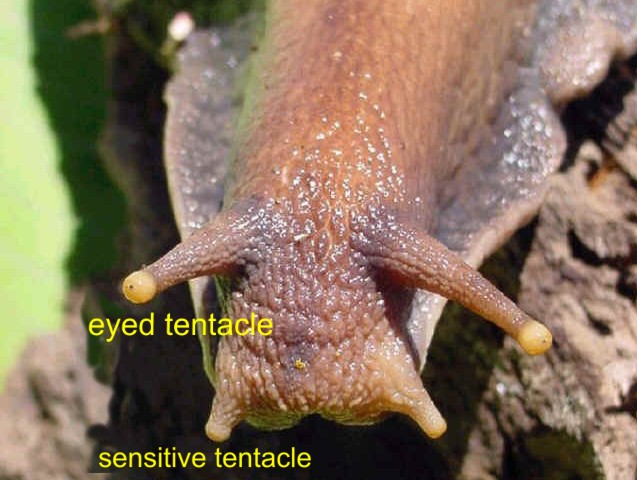
|
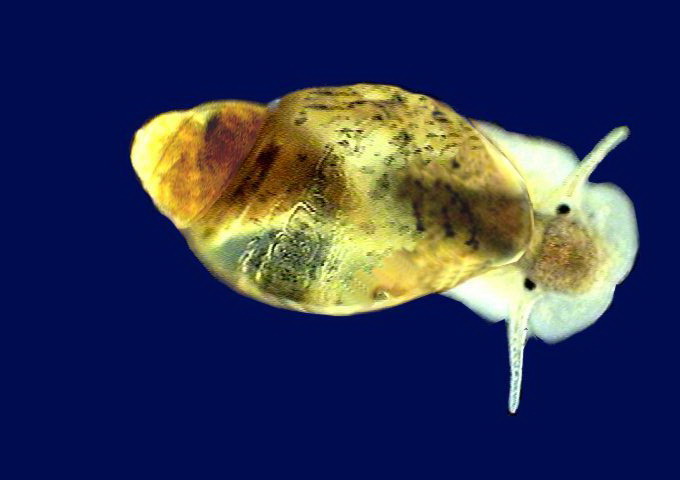
|
|
Head of a stylomatophore .
From
http://www.honoluluzoo.org/images/willy-03.htm
|
Physella sp. The
basomatophore here
discussed |
The mollusks of fresh water, like the physas, are Basomatophores. They have the eyes located next to the base of the tentacles. I had no option. when I used Internet Explorer and Google there is not on the Web such a thing as an image of a basomatophore head. So I put here my own one.
Within the shell they have in addition an ample cavity covered by a skin extension highly irrigated by blood vessels, which serves for breathing. It is called a lung, and must be filled periodically with air so that the mollusk can extract the oxygen that it needs, and unload the carbon dioxide produced by its organs. For that reason the animals raise to the surface periodically, where they make the gas interchange. Often the gaseous bubble that they eliminate can be seen as they approach the air-water interface.
Since they have a lung, even if it is so different from the human one, these gastropods are classified as pulmonate.
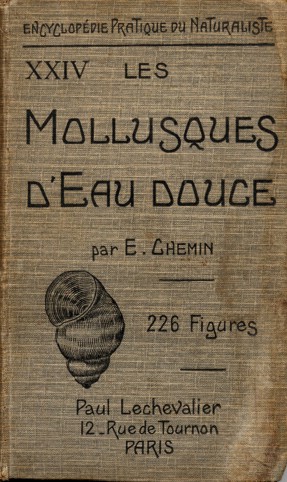
|
My first book for learning about the mollusks of fresh water was the one by E. Chemin, included in the Encyclopedie Pratique du Naturaliste, published by Lechevallier in 1926, one year before my birth, and beautifully illustrated with 226 drawings and pictures, 47 in the text and the rest included in 15 plates (4 of them colored).
Leaving apart the possible effect of the population increase, the modifications of the landscape and the pollution of aquatic environments, the book still serves perfectly like an introduction to the subject, including not only an anatomical and taxonomic review (this last one outdated of course), but also physiological data, with some interesting experiments.
I
n summary, the annoying invader of the
aquarium of my grandson is a
basomatophore pulmonate
gastropod
mollusk. The basomatophores have
several freshwater genuses. But the
well-known ones and of world-wide
distribution are
physas,
limneas, the
planorbides, and the
ancilides.
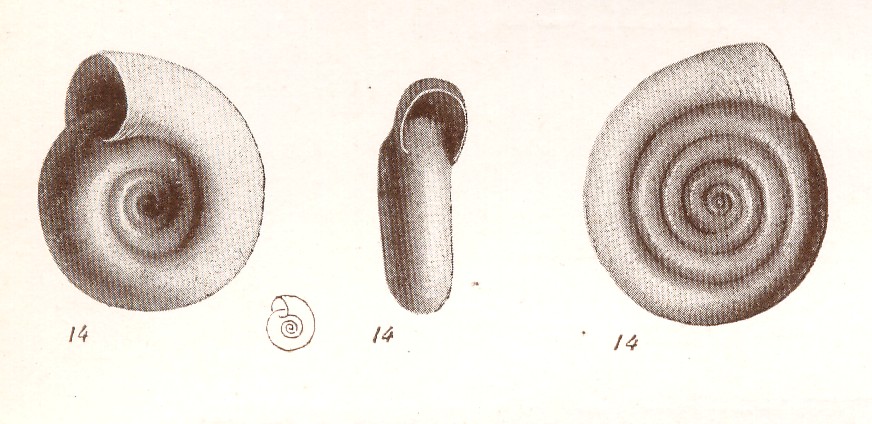
|
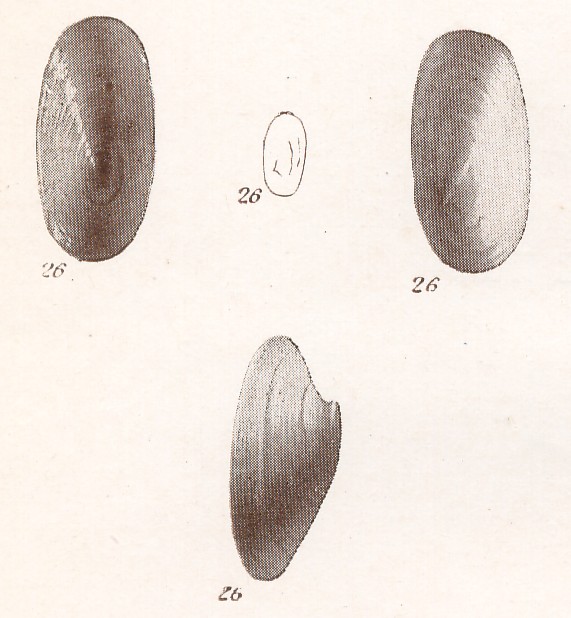
|
|
Planorbis, from the
E.Chemin book |
Ancylus,from the
same |
Ancilides and the planorbides are easy to recognize: Planorbis and similar genus have the shell spiral-coiled in a single plane, Ancylus and other ancilides have one special shell, like a flat cone opened at the ellipsoidal base, where the animal lodges.
The other existing fresh water
genuses, are distinguished by a horny
not calcified plate, dorsally adherent
to the foot, and totally adapted to
the aperture of the shell: the
operculum. When the animal retires,
the operculum closes the opening
totally, thus protecting the mollusk
from outer attacks and from drying. A
much known genus is
Pomacea.
I have found a beautiful picture in
this very interesting link on the Bishop
Museum, Hawaii website.
|
|
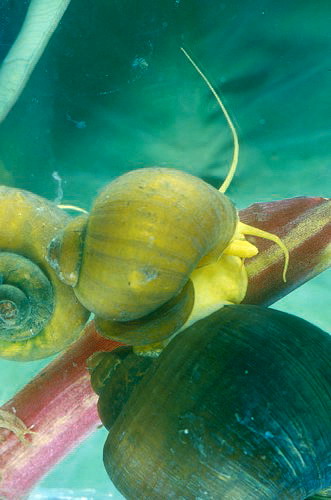
|
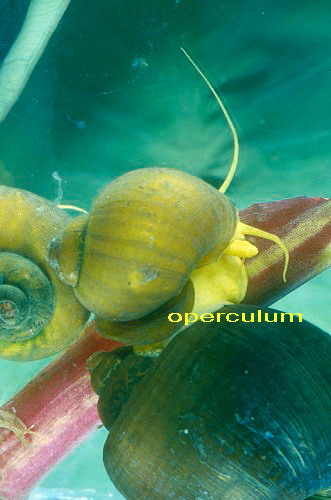
|
|
Yo can see clearly the
horny operculum of this
very big fresh water
snail, mostly known as the
"apple snail" |
|
To distinguish the physas from the limneas is only a little more difficult.
Limnaea , Lamark, 1801, has tentacles with the base wider than the end (therefore with a triangular profile) its shell is coiled towards the right, it is clockwise (dextral). If the shell is watched from its ventral side its mouth will be seen at right.
Physella ( Draparnaud, 1801 ), before denominated Physa , Draparnaud, 1801 , has filiform tentacles (cylindrical, almost of the same thickness in the base that in the end). Its shell is coiled towards the left; it is counter clockwise (sinistral) If the shell is watched from the ventral side, its mouth will be seen at left. This is the genus of my grandson nightmare.
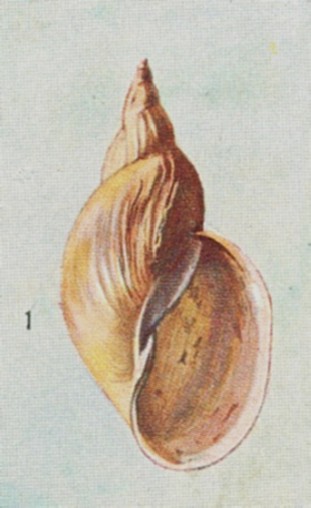
|
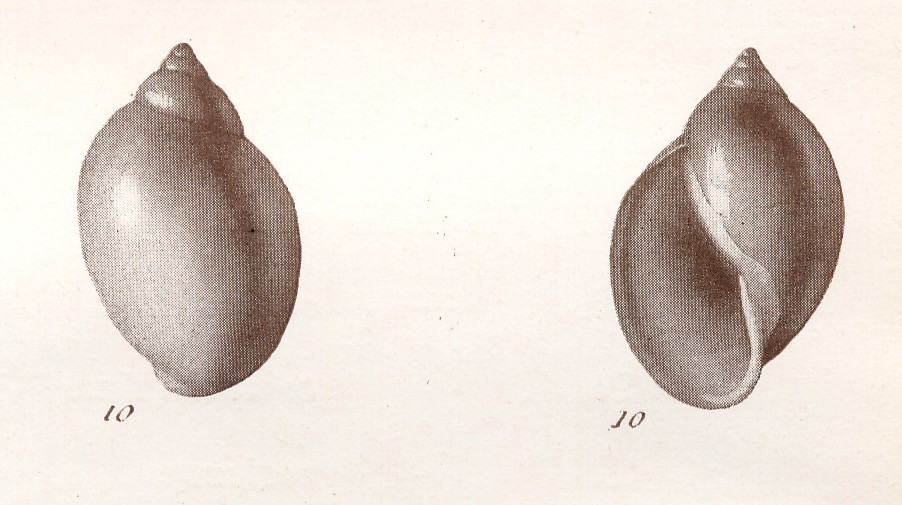
|
|
Limnea sp. |
Physella acuta, the
common cosmopolitan
Physella. Both images from
E. Chemin. See the mouth
in both shells |
An interesting detail is
that the pulmonates are
hermaphroditic. But, in most species,
self-fertilization is not possible,
and they are always need two mature
individuals for mating. Both
individuals act simultaneously as
males and females.
At this moment, according to A.R. Wethington (2005), the systematics of these groups is extremely complicated, being based on the mitochondrial DNA of the studied species, in the morphology of the penis (of which, for the genus Physella four different types are described) and in crossover tests between the morphologically differentiated species.
The commonest species is Physella acuta, (see the drawing of Chemin) which has invaded practically all fresh waters of the world, and is common in North America and Europe. For the south of the United States, Mexico, Centro and South America 3 species are cited frequently: Physella spelunca, Ph. squalida and Ph. boucardi.
Without being able to make detailed dissections and a formal study of the mitochondrial DNA, the invading species of my grandson's aquarium must resign to being modestly known as Physella sp.
But it is, anyway, an interesting subject for the study of the development of the embryo of a small fresh water mollusk.
Next
month you can read the
Second Part, to see how the
eggs of this snail fascinated me, to
the point that I postponed for a time
the expected eradication of the
"pest".
Microscopy
UK Front Page
Micscape Magazine
Article Library
© Microscopy UK or their contributors.
Published in the August 2007 edition of Micscape.Please report any Web problems or offer general comments to the Micscape Editor.
Micscape
is the on-line monthly magazine of
the Microscopy UK web
site
at
Microscopy-UK
© Onview.net Ltd, Microscopy-UK, and all contributors 1995 onwards. All rights reserved. Main site is at www.microscopy-uk.org.uk with full mirror at www.microscopy-uk.net .